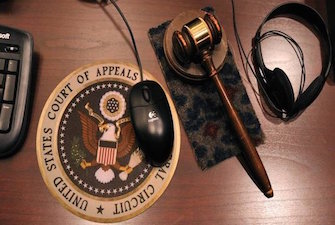“In these circumstances, there is a clear reason for a skilled artisan, knowing of the return-to-default option, to try that option. And there is no finding or argument that success would be in doubt . . .or that unexpected results would be produced.”
 On January 6, the U.S. Court of Appeals for the Federal Circuit (CAFC) reversed the Patent Trial and Appeal Board’s (PTAB) decision that Google failed to prove Koninklijke Philips’ (Philips) U.S. Patent No. RE44,913 (the ‘913 patent) obvious. The patent describes a method for entering primary and secondary characters on the keypad of a device such as a handheld mobile device. After Philips sued Acer, Inc. and other companies for infringement based on devices that use Google operating systems, Google petitioned the PTAB for inter partes review (IPR) of the ‘913 patent and the board found for Philips. Google appealed the Board’s decision to the CAFC, which held that the Philips invention would have been obvious in light of the prior art.
On January 6, the U.S. Court of Appeals for the Federal Circuit (CAFC) reversed the Patent Trial and Appeal Board’s (PTAB) decision that Google failed to prove Koninklijke Philips’ (Philips) U.S. Patent No. RE44,913 (the ‘913 patent) obvious. The patent describes a method for entering primary and secondary characters on the keypad of a device such as a handheld mobile device. After Philips sued Acer, Inc. and other companies for infringement based on devices that use Google operating systems, Google petitioned the PTAB for inter partes review (IPR) of the ‘913 patent and the board found for Philips. Google appealed the Board’s decision to the CAFC, which held that the Philips invention would have been obvious in light of the prior art.
The Invention
The ‘913 patent seeks to improve the multitap and predictive text methods for entering characters on a mobile device keypad. The invention has each key display its primary character in its default state through a quick tap of the key. To access secondary characters, the user holds the associated key for “a period longer than a predetermined time period” to display a menu of secondary characters for quick tap. Once a secondary character is selected, the keypad returns to its default display. Google challenged claims 1 and 3-16 of the ‘913 patent as being obvious on two grounds: 1) obviousness over an English translation of Japanese Patent Application No. 2000-148366 (the Sakata II application); and 2) obviousness over Sakata II in view of U.S. Patent No. 6,094,197 (the Buxton patent). Google’s appeal asserts that claim 1 is representative of all those challenged and thus the CAFC focused its discussion on claim 1.
Obvious to Try
The CAFC held that it is undisputed that any person of skill in the art would have known the teachings of the Sakata II application, as it discloses a method for inputting text using a keyboard displayed on a touch screen. The only difference between the Sakata II application and the ‘913 patent is in the last step, argued the court. In the ‘913 patent, after a secondary character is selected, the relevant key returns to the default display, whereas in Sakata II, once the secondary character is selected the relevant key changes to the selected secondary character. In its obviousness analysis, the CAFC cited the Supreme Court in KSR Intern. Co. v. Teleflex setting forth various articulations of a flexible obviousness inquiry that is not subject to a rigid formula, reflecting the need for facts stating why the formulation is obvious considering real-world pressures for innovation. Thus, if a finite solution to a technical problem is “obvious to try” in response to market pressure or design needs, a conclusion of obviousness may be made.
Google argued that it is obvious to one of ordinary skill that, in viewing Sakata II, there are only two options following entry of a second character: 1) either substitute the key with the last selected secondary character; or 2) return the key to the default state without substituting the secondary character. Philips agreed, but also shifted the argument to state that there is a wide variety of keypad techniques in general. The CAFC held that this response was an improper shifting of the inquiry to all keypad possibilities instead of addressing the relevant point made by Google as it applies to the case. Citing Perfect Web, the court held that the “obvious to try” inquiry must at least sometimes focus on known options at what is undisputedly the sole point of novelty in the claim at issue, thus asking if the sole contested step of the claim at issue was obvious to try. In this case, the CAFC found that there was no reasonable dispute that a skilled artisan would know of the return-to-default option, with the Buxton patent further confirming the familiarity of the option. “In these circumstances, there is a clear reason for a skilled artisan, knowing of the return-to-default option, to try that option,” wrote the Court. “And there is no finding or argument that success would be in doubt . . .or that unexpected results would be produced.” Additionally, the CAFC found that this option was long-familiar regarding keyboards and their shift key, which makes secondary characters available upon being held and restores primary characters upon release.
Furthermore, the CAFC held based on expert testimony that the ‘913 patent did not present a one-size-fits-all efficiency solution as an argument against obviousness. The court found that both the substitution option and the return-to-default option have the potential to be more efficient than the other depending on the user:
A chemist might often prefer substitution of a secondary-character “mg” for a primary character “mm” (to use Sakata II’s example), whereas a wire maker (using Sakata II’s keyboard) might prefer the opposite while writing about diameters rather than weights. Or a writer of English prose might prefer to retain unaccented vowels as the default option, with accented forms of those vowels as the secondary characters, while a writer of international financial news might prefer to have a key for currency symbols substitute and retain a particular symbol (such as $ or €) while writing a particular article.
According to the CAFC, Philips’ patent did not exhibit unexpected results and was reasonably expected to succeed in light of a finite number of predictable solutions. Therefore, the CAFC found the ‘913 patent’s return-to-default alternative method to character substitution to be obvious to try, and thus obvious.

![[IPWatchdog Logo]](https://ipwatchdog.com/wp-content/themes/IPWatchdog%20-%202023/assets/images/temp/logo-small@2x.png)

![[Advertisement]](https://ipwatchdog.com/wp-content/uploads/2024/04/UnitedLex-May-2-2024-sidebar-700x500-1.jpg)
![[Advertisement]](https://ipwatchdog.com/wp-content/uploads/2024/04/Artificial-Intelligence-2024-REPLAY-sidebar-700x500-corrected.jpg)
![[Advertisement]](https://ipwatchdog.com/wp-content/uploads/2024/04/Patent-Litigation-Masters-2024-sidebar-700x500-1.jpg)

![[Advertisement]](https://ipwatchdog.com/wp-content/uploads/2021/12/WEBINAR-336-x-280-px.png)
![[Advertisement]](https://ipwatchdog.com/wp-content/uploads/2021/12/2021-Patent-Practice-on-Demand-recorded-Feb-2021-336-x-280.jpg)
![[Advertisement]](https://ipwatchdog.com/wp-content/uploads/2021/12/Ad-4-The-Invent-Patent-System™.png)






Join the Discussion
No comments yet.